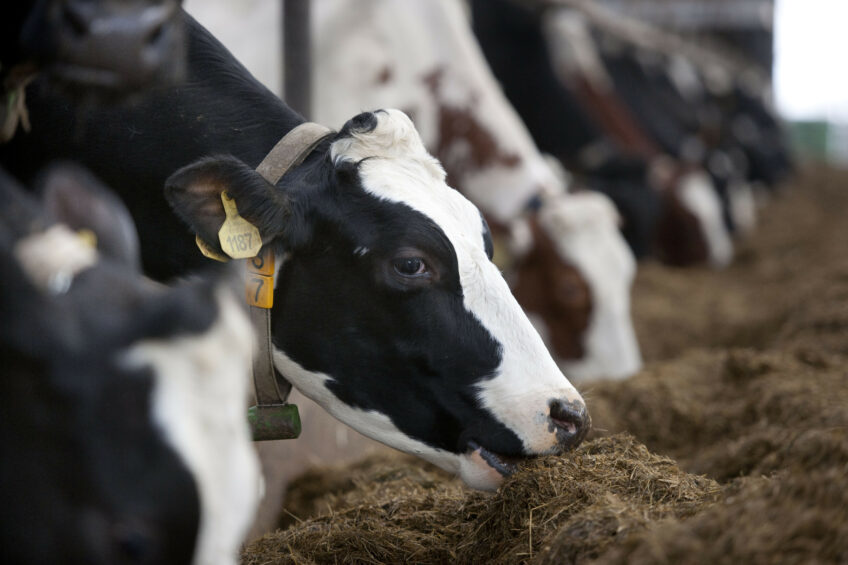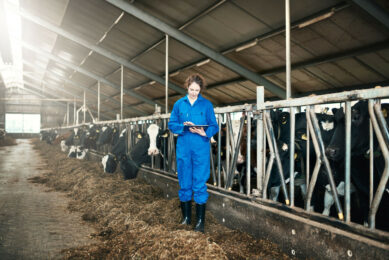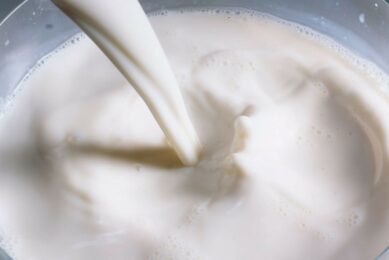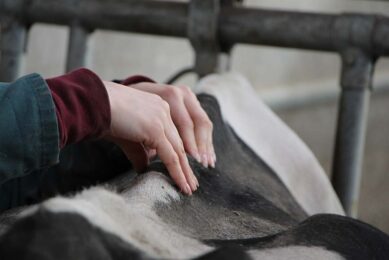Nutrient utilisation boosted by enzymes

Commonly used to unlock the potential of nutrients in poultry and swine, feed enzymes are a new innovation for ruminants and are now considered the future of dairy nutrition. The benefits of feed amylase for dairy cow rations are explained here.
To ensure maximum profitability in milk production, it is important for producers and nutritionists to optimise nutrient utilisation of a dairy cow’s diet. One area of opportunity is enhancing the nutritional value of corn in the dairy ration. To do this, special attention must be paid to feed starch content of corn and its rumen degradability, as starch plays an essential role during early lactation in cows and can have a significant impact on milk yield, quality and fertility. Commonly used to unlock the potential of nutrients in poultry and swine, feed enzymes are a new innovation for ruminants and are now considered the future of dairy nutrition by Dr Michael Hutjhens (Professor Emeritus Dairy Extension Specialist at University of Illinois). This comes following 12 years of expert research into the effects of enzymes on ruminants so that we now have a well-defined mode of action and have since developed the first feed amylase for the dairy cow market.

Starch digestibility
As the new corn and corn silage season starts in the northern hemisphere, there are many factors which affect starch degradability and digestibility including starch granule size, corn structure and the protein matrix of the starch source. New season corn and corn silage for example, is considered less degradable in the rumen than 12-month-old material. This reduced rumen degradability affects the extent of starch digestibility in dairy cows, as well as nutrient utilisation. In fact, the proportion of starch from the corn that is fermented in the rumen, and resulting energy supply, can vary considerably – up to between 50-95% depending on the corns variety, maturity and vitreousness. Similar studies have also demonstrated the negative impact of those factors on starch digestibility by the cow.
When starch is not digested in the rumen, it will flow into the small intestine, where it is hydrolysed by endogenous enzymes produced by the cow. Although an increased intestinal starch flow can increase the absorption of glucose, an important precursor of lactose for high producing dairy cows, the capacity of the small intestine to digest large quantities of starch is limited. When digestion goes beyond the duodenum, this may lead to starch losses and loose faeces, and have a negative impact on feed utilisation and milk yield.
The effect of poor starch digestibility on milk yield was clear in a study which demonstrated that each 1% reduction in faeces starch wasted equalled to 0.5kg improvement in milk yield. A simple calculation shows the financial consequences of these losses: in a dairy herd of 500 cows with a daily intake of 5.6kg corn starch at a digestibility of 95%, the cows excrete the equivalent of 21 tons of corn grain in a 100-day period. To recover this cost, farmers would need to produce 2.5ha more corn concluding a financial loss of € 3,000. These figures highlight the significant incurring costs dairy farmers face with incremental starch loss and inefficient nutrient utilisation, and with little desire to increase milk production per dairy cow, there is growing interest in other ways to produce the same amount of milk with less feed and enzymes have shown a great potential to do so.

The use of enzyme reduced the excretion of nutrients. Left is before use and right is after use of enzyme.
Converting the starch into oligosaccharides
Increasing starch digestibility and available energy concentration in the rumen has the potential to improve nutrient metabolism and enhance efficient milk production, and profitability. Enzymes, such as amylase, can play a critical role in this. One particular amylase* works in the rumen by increasing the rate of corn starch hydrolysation into oligosaccharides. The oligosaccharides fuel the activity of cellulolytic bacteria, which digest fibre in the rumen, increasing the total microbial activity in the cow. This increases total digestibility of the corn diet. It is the action of converting the starch into oligosaccharides that provides substrate for the fibrolytic bacteria, otherwise known as cross-feeding. This cross-feeding then leads to improved fibre digestibility in the rumen and more acetate, which is then absorbed in the blood stream, enters the udder and is used to help produce milk fat. A benefit of cross-feeding is that the starch is broken down into oligosaccharides and not into acids, such as propionic acid or lactic acid, and therefore the rumen’s pH remains unchanged when using this enzyme. As a result, the dairy cow will experience improved starch and fibre digestibility, more available energy and reduced waste in the faeces, with no reduction in rumen health. It is also important to note that the amylase also works in the small intestine by increasing starch digestibility. One study concluded that the amylase significantly increased organic matter digestion from 64.6% to 67.3%, and ruminal starch digestibility from 73.9% to 81.1% in dairy cows with a high starch diet of 30% (Table 1).
This is also demonstrated in the 2 images, showing corn silage, where the amylase reduced the excretion of nutrients leading to a better exploitation of the nutritive value of the ration. The increase in digestibility leads to more energy reaching the cow, particularly a higher blood glucose. In a study, blood glucose in early lactation was increased by 12.5% after the use of enzymes. This increase in blood glucose, particularly in early lactation, results in an increase in milk production.
The use of enzyme reduced the excretion of nutrients. Left is before use and right is after use of enzyme.
The data shown in Figure 1 is typical of the extra glucose levels, showing that 2.2kg more milk was produced in early lactation which increased to a peak milk yield of about 4kg. A second trial demonstrated that cows supplemented with the feed enzyme produced more milk over the entire lactation period – the additional daily milk yield of cows fed the enzyme was on average +2.214kg, and total lactation yield was increased by more than 700kg per cow.
Figure 1 – The effect of the enzyme* on milk yield.

Amylase in practise
Over the last 12 months, 16 different farm trials involving approximately 9,000 cows across Europe have evaluated the commercial benefits of the amylase tested. The results observed an average response of 1.4kg more milk production. In nine out of 11 farms the digestibility of starch in the diet was also determined by measuring starch faeces with a digestive sieve. Results proved a significant improvement in starch faeces content, showing less fibre and starch was wasted after cows were fed the enzyme. These results of course translate into financial gains, increased profitability and protection against financial loss when milk prices are low. A dairy farmer for example, might expect a € 24,000 gain in a herd of 500 cows over a 100-day period with the use of the amylase. These practical farm studies have proven that enzymes can release the full value of corn and maximise corn starch utilisation in early lactation on practical commercial dairy farms. It can therefore be concluded that enzymes play a significant role on starch digestibility and milk productivity. New data has shown promoted ruminal starch degradation, significant boosts in milk yield, increased herd efficiency, and optimised rumen health. These results demonstrate that a real breakthrough in ruminant nutrition has occurred with the arrival of enzymes for nutrient utilisation in dairy cows.
The Feed Enzymes Alliance
The dairy industry is facing the challenge of obtaining maximum profitability from milk production while keeping affordable prices, healthy animals and a safe, sustainable food chain. With the widest portfolio on the market, the DSM/Novozymes Alliance, the market leader in feed enzymes, brings innovations that allow the value chain to be more efficient, competitive and sustainable.
*RONOZYME® RumiStar
™
are trademarks of DSM (the only EFSA registered feed additive in Europe and also currently the only enzyme available on the market that works on dairy cow rumen).
References available upon request.
Join 13,000+ subscribers
Subscribe to our newsletter to stay updated about all the need-to-know content in the dairy sector, two times a week.










